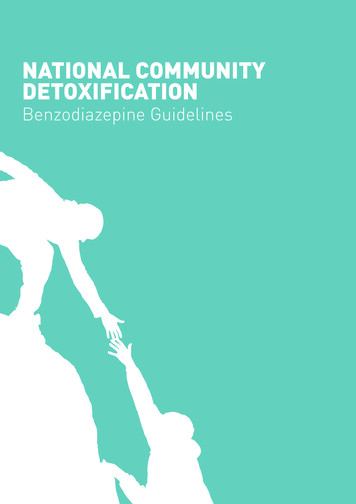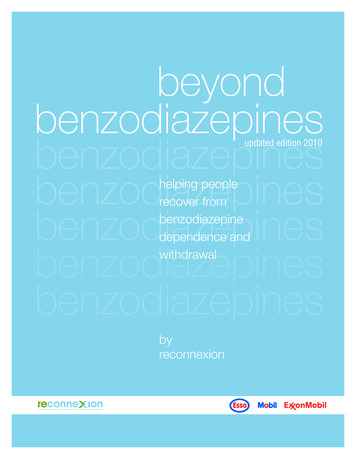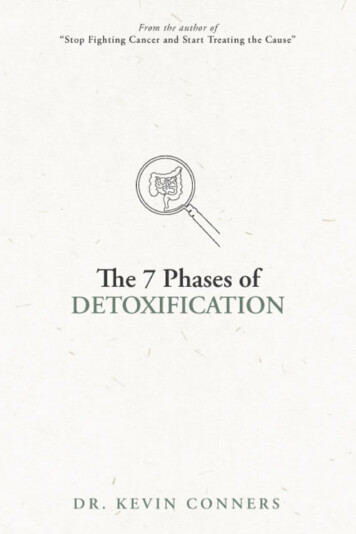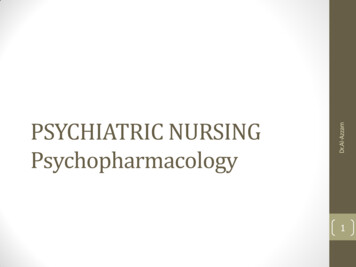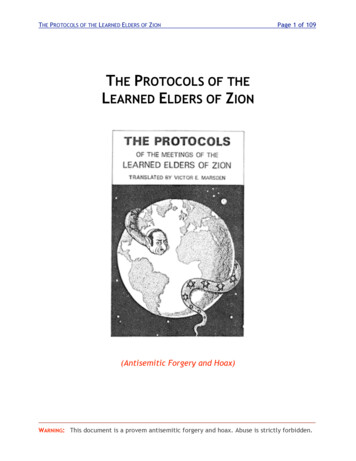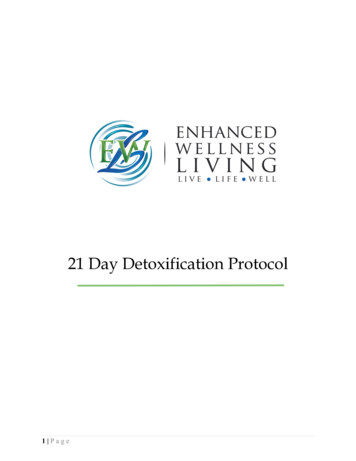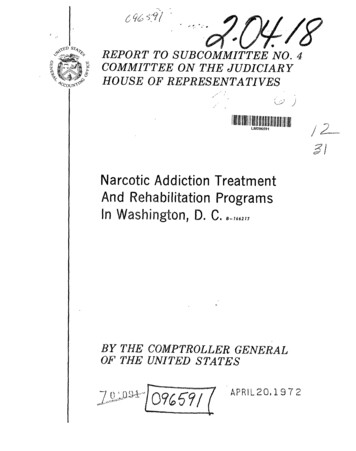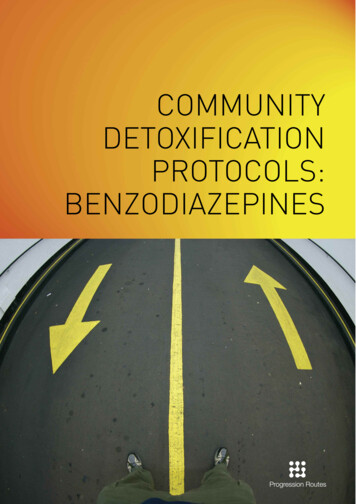
Transcription
COMMUNITYDETOXIFICATIONPROTOCOLS:BENZODIAZEPINES
COMMUNITYDETOXIFICATIONPROTOCOLS:BENZODIAZEPINES
TABLE OF CONTENTSCHAIRPERSON’S FOREWORD031OVERVIEW042INTRODUCTION042.1. HISTORY AND RATIONALE FOR COMMUNITYDETOX PROTOCOLS052.2. NORTH INNER CITY DRUGS TASK FORCE COMMUNITYDETOX EVALUATION2.3. NATIONAL COMMUNITY DETOX PILOT05062.4. GENERAL INFORMATION ON THE COMMUNITYDETOX PROTOCOLS3406BENZODIAZEPINES DETOXIFICATION PROTOCOLS073.1. COMMUNITY DETOX SUITABILITY083.2. RELATIVE CONTRAINDICATIONS083.3. COMMUNITY DETOX AND UNDER 18S093.4. BENZODIAZEPINES DETOX ENTRY REQUIREMENTS093.5. FOUR STEPS OF COMMUNITY DETOX: BENZODIAZEPINES093.6. DISENGAGEMENT15REQUIRED COMPETENCIES FOR PROFESSIONALS INVOLVED164.1 BROKER164.2 KEY WORKER164.3 DOCTOR175MANAGING INTERAGENCY DIFFICULTIES176FREQUENTLY ASKED QUESTIONS186.1. GENERAL186.2. WORKING RELATIONSHIPS186.3. SUBSTANCE USE, MEDICATION AND ENTRY CRITERIA196.4. MANAGING RISK DURING THE DETOX196.5. DISENGAGEMENT AND RELAPSE20GLOSSARY207.1 BROKER207.2 CARE PLAN207.3 KEY WORKER207.4 RELAPSE PREVENTION207APPENDIX A: BENZODIAZEPINE CONVERSION TABLE21APPENDIX B: GUIDE TO THE ROLE OF THE BROKER23APPENDIX C: SERVICE USER RISK INFORMATION AND AGREEMENT26APPENDIX D: SAMPLE DRUG DIARIES31APPENDIX E: BIBLIOGRAPHY32
C O M M U N I T Y D E TOX I F I CAT I O N P R OTO C O L S : B E N Z O D I A Z E P I N E S03CHAIRPERSON’S FOREWORDAs Chairperson of the National Community Detoxification Steering Group I would like to express myappreciation to all those involved with the development of these guidelines, in particular CarolineGardner and Aoife Dermody of Progression Routes who guided us through the process of researching,consulting, writing, reviewing and designing these Community Detoxification Protocols.The Protocols were originally developed by an expert group in 2007. In response to positive evaluationand implementation, the protocols were reviewed and augmented by an expanded steering group in 2011which included leaders in addiction services from the medical, community/voluntary and research fields.The input of every member of the steering group since the original draft in 2007 to the redraft in 2011has been invaluable. It is exciting to see the product of their diligent work in these comprehensive guidelines to outpatient detoxification. The steering group in 2011 are:Dr. Des Crowley (HSE)Brian Friel (Peter McVerry Trust)Dr. Austin O’Carroll (Safteynet)Dr. Suzi Lyons (HRB)Dr. Brion Sweeney (NDTCB)Joe Doyle (HSE)Dr. Ide Delargy (ICGP)Tony Duffin (Voluntary rep – Ana Liffey)Dr. Joanne Fenton (Access Team)Aoife Dermody (PRI)Irene Crawley (Voluntary rep, HOPE)Caroline Gardner (PRI)Ruaidhri McAuliffe (UISCE)Members of the 2007 - 2009 Steering Group also included Joan Byrne of the SAOL Project and community representative Sonja Dillon.I wish to highlight two overarching issues confronting our sector which these Community DetoxificationProtocols address; firstly, I have never met a person affected by problem substance use who at somepoint did not want to either reduce or stop the use of their drug of choice. Unfortunately, there are oftentimes when a window of opportunity opens and a person is motivated to take steps towards positivechange, but the resources are not available to support them in their goal.These CommunityDetoxification Protocols help to ensure that health services and community drug services across thecountry have the tools to collaborate to provide an accessible, timely and practical detoxification optionto service users seeking to reduce benzodiazepine use; secondly, over the last three years funding forhealth and social services in Ireland has been reduced and this is expected to continue for the foreseeable future. The Community Detoxification Protocols present a cost effective way of maximising existingresources in the community/voluntary and statutory sector to ensure a realistic detox option is availablefor people when they are ready to change.We look forward, with hope, to a positive impact on the experiences of service users seeking out-patientdetoxification, and the work of doctors and key workers who support them through use of the CommunityDetoxification Protocols.Tony Duffin, DirectorAna Liffey Drug Project19th October 2011
04P R O G R E SS I O N R O U T E S I N I T I AT I V E1 OVERVIEWCommunity detoxification supports service users to reduce or stop their use of methadone or benzodiazepines through a structured non-residential process involving key workers and prescribing doctors.This outpatient process may be chosen as an alternative to in-patient residential detoxification, or as anecessary step toward meeting entry requirements for residential detox1.This resource is targeted at doctors and key workers who are considering supporting a service userthrough an out-patient community based detox from benzodiazepines.2 INTRODUCTIONThese protocols outline minimum medical and psycho-social supports to be provided to a service userengaging in community detox. The protocols are in line with national strategic documents such as theIntroduction of the Opioid Treatment Protocol (HSE, 2010), and the National Drug RehabilitationFramework (Doyle & Ivanovic, 2010) as well as international literature on good practice service provisiondetailed in the Community Detox literature review2.It should be noted that these protocols outline agreed minimum standards for the delivery of interagencycommunity detox support. The minimum standards in short are: Interagency care planning: Care planning takes into account all factors that may negatively impacton a service user’s capacity to engage in a successful detox such as housing or family matters, as wellas those which may promote success such as meaningful use of time and social supports. Relapse prevention: Structured sessions aim to provide service users with a skills and knowledgebase around drug use, risk and relapse. Medical supports: Regular medical appointments are provided to supervise the detox. The doctoragrees to engage in interagency communications with the key worker regarding service user progressand in particular, any change to the initial detox schedule or care plan.In practice, key working services often support service users to incorporate additional elements into thecare plan process such as holistic treatments and support groups. Where there is heightened risk to theservice user (see section 3.2), additional medical and psycho-social supports should be provided.The protocols are overseen by an interagency steering group3 who are responsible for directing thedevelopment of the protocols and their implementation and evaluation, as well as responding to issuesthat arise through the process. There are two distinct community detoxification protocols documents;this one relating to detox from benzodiazepines and the second relating to methadone. While there arecommonalities in the minimum standards of supports there are important differences in the provision ofdetox options which are addressed in these protocols, including: entry and exit criteria, detox schedules,as well as structural issues such as resource constraints and levels of service provision.It is advised to check with residential services regarding entry requirementsrelating to prescribed or unprescribed drug use.12The literature review is available on www.progressionroutes.ie.3The interagency steering group includes: Dr. Des Crowley (HSE), Dr. AustinO’Carroll (Safteynet), Dr. Brion Sweeney (NDTCB), Dr. Ide Delargy (ICGP), Dr.Joanne Fenton (Access Team), Irene Crawley (Voluntary rep, HOPE), RuaidhriMcAuliffe (UISCE), Brian Friel (Peter McVerry Trust), Dr. Suzi Lyons (HRB),Joe Doyle (HSE), Tony Duffin (Voluntary rep – Ana Liffey), Aoife Dermody andCaroline Gardner (PRI).
C O M M U N I T Y D E TOX I F I CAT I O N P R OTO C O L S : B E N Z O D I A Z E P I N E S052.1 History and Rationale for Community DetoxProtocolsThe Community Detoxification Protocols were developed in the North Inner City Drugs Task Force Area inDublin, in response to a gap in treatment options for service users wishing to reduce or cease their methadoneor benzodiazepine use. This issue was identified in We’re People Too (O’Reilly, Reaper & Redmond, 2005),andthrough anecdotal evidence from service users who in some cases had reported that community detox optionswere not available to them, and that their doctors had expressed a reluctance to support them to reduce theirmedication. In these instances service users reported feeling disempowered from their treatment and frustrated that they had limited pathways to address their issues or attain their goals.Through initial consultations, methadone prescribing doctors raised concerns that service users whoengaged in a community based detox without adequate preparation or support were at considerable risk ofoverdose and fatal overdose. Doctors also highlighted that they had limited consultation times and were notin a position to provide the necessary psycho-social supports required for safer outpatient detoxification.In 2007 the Progression Routes Initiative, which had been established to address gaps and issues inservice provision and to connect national policy with service delivery, responded to this issue. Theconcerns of service users, doctors and drug services guided the formation of an initial interagencysteering group4 to progress the idea of formalised community detoxification protocols. The protocolsaimed to outline a clear process for how service users would be assessed as appropriate for a community detox and how doctors and key workers could co-ordinate to provide effective supports whilemanaging the risk of relapse and overdose. Following several months of discussions and research it wasagreed that the protocols were ready for pilot. Following a year and half of implementation, the pilot wasevaluated under the direction of the steering group.2.2 North Inner City Drugs Task Force Community DetoxPilot EvaluationThe protocols and pilot were launched in April 2007, and evaluated early in 2009. The evaluation whichincluded service users, key workers and doctors revealed a predominantly positive experience of thepilot. The full evaluation is available from www.progressionroutes.ie. The main findings were: Sixteen out of 29 service users who had an initial introductory meeting in regard to community detoxprogressed to a formal detox involving both doctor and key worker. Out of this 16, seven had successfully completed the detox and seven were still engaged. Only twodisengaged once a doctor had been involved in the process. Four of the 29 service users disengaged at the key working phase. Four of the 29 contacts received another service such as maintenance or aftercare. Referrals were spilt between; self referral (48%), community/voluntary (31%), and medical services(17%). Detox requests were similarly spilt between being opiate related (55%, no. 16) and Benzodiazepinerelated (45%, no.13). Service users reported a positive experience overall and all of them said they would recommend theprocess to a friend.Steering Group for North Inner City Pilot 2007- 2010: Dr. Des Crowley (HSE),Dr. Austin O’Carroll (Safteynet), Ruaidhri McAuliffe (UISCE), Joan Bryne4(Voluntary rep - SAOL), Tony Duffin (Voluntary rep – Ana Liffey), Sonja Dillon(SOILSE), Caroline Gardner (PRI).
06P R O G R E SS I O N R O U T E S I N I T I AT I V E2.3 National Community Detox PilotIn response to a number of referrals from outside Dublin’s North Inner City and growing interest in theinitiative, a national pilot was proposed to and approved by the steering group. PRI were invited topresent the protocols to local and regional drugs task forces and sub-groups during late spring and earlysummer 2011. A number of areas were prioritised for involvement in the National Pilot in autumn 2011.2.3.1 Community Detox National Pilot Evaluation: Under the guidance of the steering group an evaluation of the national roll-out of the community detoxification protocols will be conducted during2011/2012.2.3.2Community Detox Literature Review: A literature review is available on www.progressionroutes.ie.This includes information on the following: National context for community detox International good practice guidelines for detoxification Outpatient and residential detoxification research Efficacy of psycho-social supports during and after detoxification Mitigating risk factors for overdose during and after detoxification Detoxification prescribing2.4 General Information on the Community DetoxProtocols2.4.1Resources to Support the Community Detox ProtocolsThere are resources available to support the roll out of community detox, downloadable fromwww.progressionroutes.ie, community detox section. These include: Service User Information Literature Relapse Prevention Resources Sample Assessment and Care Plan Forms Community Detox Literature Review Community Detox North Inner City Pilot Evaluation2.4.2Community Detox Professional Liability The Community Detox Protocols are a set of guidelines to assist professionals to supportservice users through an out-patient detoxification. In line with these protocols the localbroker (See Appendix B) may provide advice to supporting professionals as to how they maybe applied in specific situations. It is the responsibility of the organisations involved to ensure that staff providing communitydetox are competent in their role and have the appropriate level of insurance to cover theirwork. Clinical Governance for doctors: prescribing doctors are responsible for their own clinicalgovernance, or work under the clinical governance structures established within theirservice. Clinical Governance and key working services: where clinical governance is required, e.g. forthe treatment of Under 18’s, it is the responsibility of the organisation providing the service to
C O M M U N I T Y D E TOX I F I CAT I O N P R OTO C O L S : B E N Z O D I A Z E P I N E S07acquire this. The Progression Routes Initiative may be contacted for guidance on establishinga clinical governance framework. Neither the local broker nor the individuals and organisations associated with the development and production of the Community Detox protocols accept responsibility for any harm toservice users or professionals while working in line with these protocols.2.4.3Differences in Approach: Methadone and Benzodiazepine DetoxWhile many features of a benzodiazepine detox and a methadone detox are similar, the community detox process differs for each in the following ways.EXIT POINTS:Exit points (the dose at which the service user ceases reduction) differ. Methadone detox may bepaused or suspended and a maintenance dose prescribed, whereas the aim under theBenzodiazepine Protocols is to reduce to a zero dose. There may be situations where prescriberssupport a service user to remain on a low dose of benzodiazepines with a view to further reductionif/when appropriate. Careful evaluation is needed in the case of service users with previous psychiatric issues or who were previously on a benzodiazepine prescription. (See also point 3.1 & 3.2).Additional specialist community mental health supports should be enlisted where appropriateENTRY REQUIREMENTS:Entry requirements aim to ensure, as much as possible, that a service user is adequatelyprepared, supported and motivated. Urinalysis will provide information on opiate use, but in thecase of benzodiazepines, current use cannot be so easily measured. In each instance, the professional opinion of the key worker and doctor, based on their observation of the service user, willplay a considerable role in assessing whether or not the service user meets the entry criteria andis ready to detox.Please note that further general information about community detox is available in the FAQsection.3 BENZODIAZEPINE DETOXIFICATIONPROTOCOLSThis section details steps in the community detox process: assessing suitability, meeting entry requirements, and the detoxification process itself. It is important to note that where the protocols are beingused it is presumed that all parties are working in line with these protocols. Any divergence from theprocess outlined in these protocols should be discussed in a three way meeting between the serviceuser, key worker and doctor, and the local broker should be notified.
08P R O G R E SS I O N R O U T E S I N I T I AT I V E3.1 Community Detox SuitabilityWhen considering ceasing benzodiazepine use, a service user is encouraged to consider their options.Available options currently include (but may not be limited to): Residential in-patient detox Detox arrangement with the prescriber with informal psycho-social support or no external psychosocial support Self-detox.For some service users, none of these is a practical or accessible option. In the case of self-detox, thereare considerable risks involved. Supported community detox can provide a viable alternative. Communitybased detox may suit a service user who wishes to cease benzodiazepine use and who: Needs to reduce or cease their current intake to meet residential rehabilitation entry requirements;some in-patient facilities require candidates be benzodiazepine free. Specific entry requirementsshould be sought from facilities prior to referral. Does not wish to avail of in-patient detox, possibly due to childcare or work commitments. Is not considered appropriate for referral to inpatient detox. Feels that residential waiting lists are too long and wishes to take a proactive approach.3.2 Relative contraindicationsIf one or more of the following factors is present, the potential for detox should be discussed in a threeway meeting between the service user, doctor and key worker. If a service user is contraindicated as percriteria below, they are not automatically precluded from engaging in a community detox. Options suchas residential treatment or additional support in the care planning process should be considered. Severe mental health problems which are currently untreated. History of epileptic seizures while undergoing detoxification. Major medical illness. Possible dual addiction, where both addictions are unstable or where a second addiction other thanopiates is uncontrolled, (for example cocaine, alcohol and benzodiazepines). Active ongoing treatment for Hepatitis C. Pregnancy.A doctor may decline to detox a service user in their care if they feel that detox would, at this time, posesignificant risk to the health or life of the patient. Where this occurs the doctor should: Give a clear explanation to the service user for this decision. Identify risks associated with the contraindicating factor so the service user can work towards satisfying criteria for beginning the detox. This may include managing other substance use, extending thepreparatory phase, attending to health issues or any other supports put in place. Agree a time-frame for review of the decision with all parties.In the unusual circumstance that a community detox is medically contraindicated: This should be clearly explained to the service user. Other more appropriate options should be considered, such as residential detoxification.Concerns regarding someone’s suitability for referral to detox, or to start a detox are not unusual. TheFAQ section provides clarity on some common issues that arise.
C O M M U N I T Y D E TOX I F I CAT I O N P R OTO C O L S : B E N Z O D I A Z E P I N E S093.3 Community Detox and Under 18sUnder 18s in general do better in treatment when the parents/guardians are actively involved. However,this is not always possible and the law is not explicit on the issue of consent in relation to treatmentprovision. Services considering providing community detox to a person under 18 years of age shouldhave established procedures for gaining parental/guardian consent and policies and procedures in linewith relevant legislative frameworks agreed in consultation with their clinical governance provider.Where parental consent is not forthcoming, the issue becomes more complex, and local governanceprocedures should be followed closely. Further information on this is available in the QuADS SupportProject library in the Service Provision to Under 18’s Policy 5. Please note that a specific consent formfor working with people under 18 years of age is available from Progression Routes.3.4 Benzodiazepine Detox Entry RequirementsThe requirements to enter benzodiazepine detox are to: Provide minimum 14 consecutive days’ drug diaries (see Appendix D) for the period immediatelyleading up to initiation of detox. Follow doctor’s advice regarding reduction to entry dose level of unprescribed benzodiazepine use. Attend a minimum of four sessions covering relapse prevention and care planning and havecompleted an interagency care plan. While these sessions can take place over a minimum of twoweeks leading up to the detox, ongoing weekly sessions should take place until the service user isready and meets the other entry requirements. Present to the key worker and doctor as unaffected6 and fully able to engage in the process.Other relevant information regarding detox entry: Once entry requirements have been met, the doctor should be informed, and sent a copy of the drugdiaries and care plan. The key worker should notify the doctor of any delays, changes in care plan or changes in circumstance that may affect initiation of the detox. If the service user is not meeting entry requirements, initiation of the detox should be postponed untilthe criteria have been met. If the service user misses an appointment with the doctor or key worker without reason or rescheduling, then the other professional will be contacted. If there is an issue or concern then the serviceuser will be invited to a three way meeting to discuss what additional supports may be required. Sucha meeting may be called by the doctor or key worker and at a time and location convenient to all.Note: This section should be read in conjunction with Section 3.5, below.3.5 Four Steps of Community Detox: Benzodiazepines Section 4 & Appendix A contain further information on the role of broker, key worker and doctor. All forms not included as appendices are available from www.progressionroutes.ie, unless otherwiseindicated.Downloadable at: http://www.progressionroutes.ie/index.php?page quadssupport-project5Unaffected refers to a professional observational assessment that theservice user is not illicitly using drugs other than the drug from which theyare being detoxed and is not presenting under the influence of alcohol.6
010P R O G R E SS I O N R O U T E S I N I T I AT I V EStep 1 – Brokering the Doctor and Key WorkerOVERVIEW:TOOLS:Every service user who requests a communityCommunity Detox Participation Agreement.detox requires a doctor and a key worker whoService User Risk Information & Agreement.understand the process and can undertake theroles as described in these protocols. It is thebroker’s job to negotiate involvement andsupport professionals in these roles.PROCESS:1 Refer: The key worker, service user or doctor can make referrals to the broker.2 Engage:- As required, the broker will contact the doctor and key worker to explain the community detoxprocess and convey all relevant information. If useful an information meeting can be arranged.- It will be communicated that professionals are not obliged to engage in the process.- Where engaging a new key working service, the manager will be informed of the process andrequested to sign a Community Detox Participation Agreement which outlines roles andcompetencies.- Where a doctor has reservations regarding provision of community detox, the steps outlined inpoint 6.2 should be followed.3 Inform:- The broker will meet with the service user and key worker to outline the process and answerquestions, highlighting entry criteria and other treatment options such as residential detoxification.- The broker will make clear in the initial meeting that the community detox service cannot beguaranteed, as it is dependent on the participation of a doctor which must be negotiated on acase by case basis.4 Agree:- The broker, key worker and service user will discuss the risks associated with detox detailed inForm 1: Service User Risk Information and Agreement (see Appendix C). This form should besigned by the service user.- A copy should be retained by the broker, service user and key worker, and a copy forwarded tothe doctor.5 Confirm:The broker will ensure that the doctor and key worker each have:- Contact information for one another and for the broker.- A copy of the signed Service User Risk Information and Agreement.- A copy of the Community Detox Protocols.- Suggested next steps.6 Where a key worker and doctor have a previous working relationship the broker will not need tofacilitate communication between them as per point 5 in this section.
C O M M U N I T Y D E TOX I F I CAT I O N P R OTO C O L S : B E N Z O D I A Z E P I N E S011Step 2 – PreparationOVERVIEW:TOOLS:The service user and key worker begin keyDrug Diariesworking sessions prior to the doctor beginningAssessment and Care Plan forms7dose reduction. This is to support the serviceRelapse Prevention Resources8user to meet entry criteria by establishing orreviewing the care plan and to begin relapseprevention work.PROCESS:1 Risk: The risk of withdrawal, seizures and overdose during detoxification will be discussed withthe service user by both doctor and key worker.2 Entry Criteria: Entry criteria will be met as per section 3.4.3 Relapse prevention and care planning: The key worker and service user will spend a minimumof one hour per week doing relapse prevention and care planning. Where need is identified, thisis frequently conducted twice weekly for the initial few months. The tasks of care planning andrelapse prevention should be clearly differentiated with time being allocated for each.4 Barriers to detox: If the service user is presenting as affected, or there are other risk factorspresent then:- This should be discussed, preferably in a three way meeting, between key worker, doctor andservice user. The meeting can be called by any party. Where such a meeting is not possible,concerns can be dealt with in a conversation by phone between the doctor and key worker, andin person between the service user and each of the supporting professionals.- Time for preparation for detox should be extended as appropriate.5 Beginning the detox:- Once entry criteria have been met, the drug diaries & care plan should be forwarded to thedoctor, which should trigger the start of the detox. This care plan should be delivered by fax,post or in a one to one handover, as appropriate. If the service user brings a copy of their careplan to their appointment with the doctor, then the key worker should contact the doctor toinform of this arrangement.- Once the doctor is agreeable to begin the detox, they will inform the key worker and provideinformation on the detoxification schedule to be used.Forms or templates usually used by the service or in the local area, for suchpurpose. If such templates are not available please contact ProgressionRoutes for guidance.78See Glossary
012P R O G R E SS I O N R O U T E S I N I T I AT I V EStep 3 – DetoxificationOverview:Tools:This stage involves the service user reducingAssessment and Care Plan Formsmedication in line with a schedule agreed withRelapse Prevention Resourcesthe doctor. The key worker continues to providecare planning support and relapse preventionthroughout the detoxification period.Process:1 Following receipt of the drug diaries and once the doctor is agreeable to begin the detox, they willinform the key worker. It is useful if the doctor makes the detox schedule available to both the keyworker and service user.2 To assess entry dose and inform the detox schedule, doctors should calculate the average doseover at least three days as reported in the drug diaries. The table in Appendix A should be used totranslate usage into equivalent diazepam2 to enable the starting dosage and reduction levels to becalculated.3 The doctor will meet with the service user every two weeks, although appointments will beprovided more or less frequently depending on a factors relating to the service user’s stability, atthe discretion of the doctor.4 Daily dispensing from the pharmacy should be in place. After a given period of time this may bereconsidered where:- The service user is showing commitment to detox (indicated by consistent attendance at meetings and engagement with care plan, absence of behaviour which indicates mismanagement ofdrugs, etc) a move to less frequent dispensing may be used as an incentive to continuedprogress.- The service user is showing commitment to detox (as indicated above) and has extraneouscommitments such as work or family which would be facilitated by less frequent dispensing5 The key worker and service user will continue a minimum of weekly meetings which will includerelapse prevention work and care planning. Key workers should continue to highlight risks toservice users.6 Where there is an issue or concern perceived by the key worker, doctor or service user regardingrisk of relapse or capacity to adhere to the detox, then the service user will be invited, preferablyin a three way meeting, to discuss what additional supports are required and how the care planand/or detox schedule should be adapted.7 Where a service user misses an appointment, the key worker and doctor should endeavour to makecontact with the service user to highlight risks.8 If the service user misses two appointments with the doctor or key worker without reason orrescheduling, then:- The other professional will be contacted.- A discussion will be scheduled as per point 6 above.- Ongoing non-attendance will be treated as disengagement as per section 3.6.Further information on managing risk during a detox
2.1. history and rationale for community detox protocols 05 2.2. north inner city drugs task force community detox evaluation 05 2.3. national community detox pilot 06 2.4. general information on the community detox protocols 06 3 benzodiazepines detoxification protocols 07 3.1. community detox suitability 08 3.2. relative contraindications 08 3.3.
